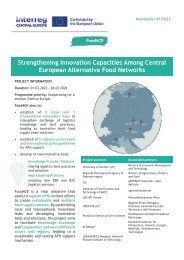The EU, the EEU, and the War in Ukraine: Political Risks and Management Options
This special issue entitled “The EU, the EEU, and the War in Ukraine: Political Risks and Management Options” is published within the framework of the Jean Monnet Network project “The EU and the EEU: Between Conflict and Competition, Convergence and Cooperation” (EUCON). The aim of this project co-funded by the Erasmus+ programme is to explore the complexity of relations between the European Union and the Eurasian Economic Union.
This special issue entitled “The EU, the EEU, and the War in Ukraine: Political Risks and Management Options” is published within the framework of the Jean Monnet Network project “The EU and the EEU: Between Conflict and Competition, Convergence and Cooperation” (EUCON). The aim of this project co-funded by the Erasmus+ programme is to explore the complexity of relations between the European Union and the Eurasian Economic Union.
- No tags were found...
You also want an ePaper? Increase the reach of your titles
YUMPU automatically turns print PDFs into web optimized ePapers that Google loves.
Hannes Meissner / Johannes Leitner<br />
<strong>The</strong> miscalculation by many <strong>in</strong> <strong>the</strong> West that Russia would not start a war for economic rationality<br />
shows how dom<strong>in</strong>ant <strong>the</strong> neoliberal perspective that economic <strong>in</strong>terests of countries <strong>and</strong> nonstate<br />
actors dom<strong>in</strong>ate <strong>the</strong> <strong>in</strong>ternational arena has become. For this reason, national security<br />
<strong>in</strong>terests <strong>and</strong> non-read<strong>in</strong>ess for cooperation – as predicted by neorealism – have re-entered <strong>the</strong><br />
academic debate about <strong>in</strong>ternational politics. One th<strong>in</strong>g is clear, though. <strong>The</strong> new global constellation<br />
will have far reach<strong>in</strong>g consequences, not only for politicians, but also for enterprises.<br />
Consequently, both policymakers <strong>and</strong> managers must adapt to new realities.<br />
This chapter is dedicated to both <strong>the</strong> political risk constellation prior to February 24 th <strong>and</strong> to <strong>the</strong><br />
political risk constellation s<strong>in</strong>ce <strong>the</strong> Russian attack on Ukra<strong>in</strong>e. In <strong>the</strong> former regard, it presents<br />
results from a field trip to Kiev <strong>in</strong> October 2021, deal<strong>in</strong>g with <strong>the</strong> follow<strong>in</strong>g questions: In what ways<br />
are companies confronted with political risks related to competition <strong>and</strong> conflict <strong>in</strong> <strong>the</strong> course of<br />
<strong>EU</strong>-E<strong>EU</strong> relations? How do <strong>the</strong>y perceive <strong>the</strong> conflict <strong>in</strong> general? How do <strong>the</strong>y manage <strong>the</strong> risks?<br />
Additionally, <strong>the</strong> chapter sheds light on <strong>the</strong> managers’ perceptions of <strong>the</strong> root causes of <strong>the</strong><br />
conflict between Russia <strong>and</strong> <strong>the</strong> <strong>EU</strong> as well as <strong>the</strong>ir ideas on future cooperation <strong>and</strong> convergence<br />
between <strong>the</strong> <strong>EU</strong> <strong>and</strong> <strong>the</strong> E<strong>EU</strong> (prior to February 24 th ). In <strong>the</strong> latter regard, this chapter provides an<br />
outlook on <strong>the</strong> new political risk constellation <strong>and</strong> risk management strategies under <strong>the</strong> current<br />
conditions.<br />
<strong>The</strong> follow<strong>in</strong>g section (section two) <strong>in</strong>troduces <strong>the</strong> concept of political risk. In this context, it<br />
provides <strong>the</strong> analytical structure <strong>the</strong> empirical study (section four) draws on. Section three offers<br />
<strong>in</strong>sights <strong>in</strong>to <strong>the</strong> methodology applied to <strong>the</strong> research project. <strong>The</strong> empirical study (section four)<br />
provides answers to <strong>the</strong> questions <strong>in</strong>troduced above. <strong>The</strong> field study to Kiev took place <strong>in</strong> October<br />
2021, four months prior to <strong>the</strong> Russian attack. Section five takes a f<strong>in</strong>al look at <strong>the</strong> new political<br />
risk constellation s<strong>in</strong>ce February 24 th , focus<strong>in</strong>g on war <strong>in</strong> Ukra<strong>in</strong>e as well as Russia’s tighten<strong>in</strong>g<br />
grip on post-Soviet countries.<br />
2 <strong>The</strong> concept of <strong>Political</strong> Risk<br />
<strong>The</strong> <strong>in</strong>ternationalisation of a company is usually associated with an <strong>in</strong>creased risk. <strong>The</strong> risks<br />
arise ma<strong>in</strong>ly from <strong>the</strong> fact that <strong>the</strong> company is enter<strong>in</strong>g a new market that may differ culturally,<br />
socially, economically, legally, politically-<strong>in</strong>stitutionally as well as structurally – i.e., <strong>in</strong> <strong>the</strong><br />
constellation of <strong>the</strong> competition <strong>and</strong> local market preferences. Above all, <strong>the</strong> transformational<br />
eco nomies <strong>in</strong> <strong>the</strong> post-Soviet region <strong>in</strong>cur a heightened risk portfolio (Hoskisson et al 2000;<br />
Meschi 2005; Alcantara/Mitsuhashi 2013). In addition to socio-economic <strong>and</strong> market risks,<br />
<strong>the</strong>re are also specific political risk factors that have a significant <strong>in</strong>fluence on <strong>in</strong>ternational<br />
bus<strong>in</strong>ess activities (Leitner/Meissner 2017). In this context, risk refers above all to <strong>the</strong> possible<br />
negative consequences for <strong>the</strong> company’s bus<strong>in</strong>ess activity <strong>and</strong> profitability <strong>in</strong> <strong>the</strong> respective<br />
foreign market due to unforeseen changes <strong>in</strong> <strong>the</strong> bus<strong>in</strong>ess environment (March/Shapira 1987;<br />
Al Khattab et al. 2007). <strong>The</strong> bus<strong>in</strong>ess environment refers to all variables that def<strong>in</strong>e <strong>the</strong> framework<br />
for entrepreneurial activity <strong>in</strong> a particular market, <strong>and</strong> <strong>in</strong>cludes both microeconomic <strong>and</strong><br />
8 Wirtschaft und <strong>Management</strong> · B<strong>and</strong> 33 · März 2023















